
L-R: Ching Neng Bin, Chan Meng Fye, Chia Chai Ling, Chew Leng Soon at Sirindhorn Dinosaur Museum.
Day 4 (19.11.2015) Khon Kaen City to Kalasin (80km)
This morning we went to Kalasin by bus at 10:00 and arrived at the new bus station at 11:40. We then took a tuktuk to a nearby location and stayed at the AP Garden next to Kud Nam Kin Lake.
Kalasin, the land of Pong Lang music and the famous Phrae Wa cloth, is also the site of the ancient city of Fa Daet Song Yang and one of the largest collections of dinosaur fossils in northeastern Thailand.
At 1pm, we took a van from the bus station to Sirindhorn or Phu Kum Khayo Dinosaur Museum where we had lunch. On the way back, we stopped at Kalasin City and visited the Kalasin City Shrine, Wat Klang a third-class royal temple and Wat Tai Pho Kham.
Sleeping at AP Garden, Kalasin.

Morning breakfast in a shop opposite our Rome Hotel in Khon Kaen.

Morning breakfast in a shop opposite our Rome Hotel in Khon Kaen.

The Khon Kaen bus that dropped us in Kalasin bus station.

We took this smaller songthaew to the nearby AP Garden Hotel in Kalasin.

We stayed at the AP Garden Hotel next to Kud Nam Kin Lake in Kalasin for TB400 per twin room.

We stayed at the AP Garden Hotel next to Kud Nam Kin Lake in Kalasin for TB400 per twin room.

In front of AP Garden Hotel, Khud Nam Kin Lake is a park just west of the Kalasin bus station. A very nice little lake with a recreational park on the west side. In the evenings, many locals come here to jog around the lake and use the public exercise equipment, including the small gym there.

We had Som-Tam for lunch in front of Sirindhorn Dinosaur museum, Kalasin.

Sirindhorn Dinosaur Museum near Sahatsakhan, 31km from Kalasin. Whole body bones were found. Most were large, long-necked, herbivorous sauropods that lived about 130 million years ago.
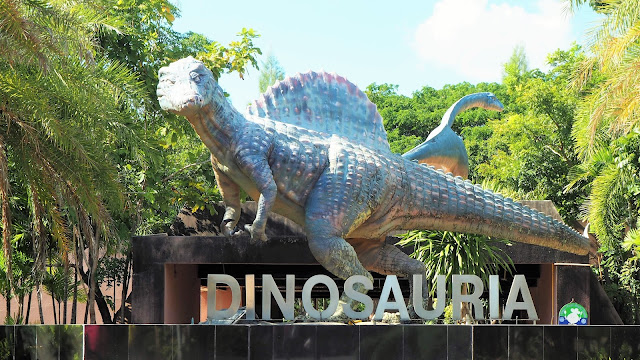
Kalasin has the largest concentration of Jurassic dinosaur fossils in northeastern Thailand at Phu Khum Khayo where archaeologists unearthed entire sauropod fossils.

There are many dinosaur sculptures in the garden of Sirindhorn Museum. About 200 meters from the museum's main building, on the slopes, is an excavation site that reveals original dinosaur fossils buried underground. More than 700 dinosaur bones have been found here.

Many dinosaur sculptures in the garden of Sirindhorn Dinosaur museum, Kalasin.

L-R: Ching Neng Bin, Chew Leng Soon, Chia Chai Ling, Chan Meng Fye at Sirindhorn Dinosaur Museum.

There are many dinosaur sculptures in the garden of Sirindhorn Dinosaur museum, Kalasin.

The museum was named by Princess Maha Chakri Sirindhorn. A two-storey building, its interior is filled with mysterious walkways guiding visitors to travel back in time to the Palaeozoic Era. Walking through the tunnels, visitors reach various exhibition halls about Geology, the beginnings of the Earth and how it was formed, as well as the evolution of living creatures such as dinosaurs and humans. The 8 exhibition zones: 1st zone: The Origin of the Earth and Universe. 2nd: The Origin of the Living Things. 3rd: Paleozoic Era. 4th: Mesozoic Era, Thai dinosaur. 5th: Dinosaurs in Thailand. 6th: Bring life to dinosaur. 7th: Cenozoic Era. 8th: Human being.

In the main museum the whole evolvement of the universe is sketched, beginning with the big bang theory and the development of the solar system with it's tenth planet has been discovered.

The Earth’s Geologic Time Scale. Evidence from radiometric dating indicates that the Earth is about 4.570 billion years old. The largest defined unit of time is the supereon, composed of eons. Eons are divided into eras, which are in turn divided into periods, epochs and ages. The terms eonothem, erathem, system, series, and stage are used to refer to the layers of rock that correspond to these periods of geologic time. Years are expressed as MYA or MA, meaning “million years ago.”
Eon: Half a billion years or more.
Era: Several hundred million years.
Epoch: Tens of millions of years.
Age: Millions of years.

The following zones describe and illustrate the geological development of the early Earth and subsequent biological evolution.

The Sirindhorn Dinosaur Museum in Kalasin displays beautiful stones and crystals.

The Sirindhorn Dinosaur Museum in Kalasin displays beautiful stones and crystals.

The Sirindhorn Dinosaur Museum in Kalasin displays beautiful stones and crystals.

The Paleozoic Era was 200 million years ago, long before humans existed. Dinosaurs once lived in this area, and their fossils lie beneath the plains of sandstone beds. Therefore, the museum is not only the most complete and largest dinosaur museum in Southeast Asia, but also a research center.

The Cambrian Period was the first geological period of the Paleozoic Era, and of the Phanerozoic Eon. The Cambrian lasted 53.4 million years from the end of the preceding Ediacaran Period 538.8 million years ago to the beginning of the Ordovician Period 485.4 mya. Its subdivisions, and its base, are somewhat in flux.

This is a beautiful, 2.95" long Asaphus lepidurus trilobite. It was collected from the Putilovo quarry in the St. Petersburg region of Russia.

This is a beautiful, 2.95" long Asaphus lepidurus trilobite. The caramel colored shell contrasts nicely with the light colored limestone.

The Silurian is a geologic period and system spanning 24.6 million years from the end of the Ordovician Period, at 443.8 million years ago, to the beginning of the Devonian Period, 419.2 Mya. The Silurian is the shortest period of the Paleozoic Era.

This is a large example of the classic US trilobite, Dalmanites limulurus. It was collected in the famous Caleb Quarry near Middleport, NY.

The Devonian is a geologic period and system of the Paleozoic, spanning 60.3 million years from the end of the Silurian, 419.2 million years ago, to the beginning of the Carboniferous, 358.9 Mya. It is named after Devon, England, where rocks from this period were first studied.

Bothriolepis canadensis.

Ammonites were shelled cephalopods that died out about 66 million years ago.

A more comprehensive display of such fossils can be found at the Sirindhorn Museum in Kalasin.

A more comprehensive display of such fossils can be found at the Sirindhorn Museum in Kalasin.
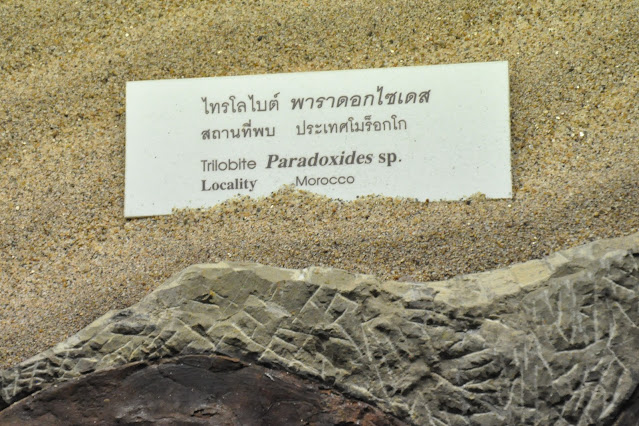
Paradoxides is a very large trilobites found throughout the world during the Mid Cambrian period.

The Carboniferous period that spans 60 million years from the end of the Devonian Period 358.9 million years ago, to the beginning of the Permian Period, 298.9 million years ago.

Neuropteris is an extinct seed fern that existed in the Carboniferous period.

Sphenopteris is a seed ferns of extinct plants, ranging from the Devonian to late Cretaceous period.


The Permian is a geologic period spans 47 million years from the end of the Carboniferous Period 298.9 million years ago, to the beginning of the Triassic Period 251.9 Mya. It is the last period of the Paleozoic Era; the following Triassic Period belongs to the Mesozoic Era.

Brittle stars, serpent stars, or ophiuroids are echinoderms related to starfish. They crawl across the sea floor using their flexible arms for locomotion. The ophiuroids generally have five long, slender, whip-like arms which may reach up to 60 cm in length on the largest specimens.

Ammonites were shelled cephalopods that died out about 66 million years ago.

The Sirindhorn Dinosaur Museum in Kalasin

The Sirindhorn Dinosaur Museum in Kalasin.

Among the Sirindhorn Dinosaur Museum's excellent exhibits are life-size skeletons of many of the important dinosaur species discovered in the region. The museum also displays an actual archaeological dig site where six dinosaur fossils were unearthed from the same bed level.

A standout exhibit at the Sirindhorn Dinosaur Museum is the display of real, life-size fossils.

A standout exhibit at the Sirindhorn Dinosaur Museum is the display of real, life-size fossils.

A standout exhibit at the Sirindhorn Dinosaur Museum is the display of real, life-size fossils.

A standout exhibit at the Sirindhorn Dinosaur Museum is the display of real, life-size fossils.

Dinosaur eggs are at least 20 cm long and weigh hundreds of grams.
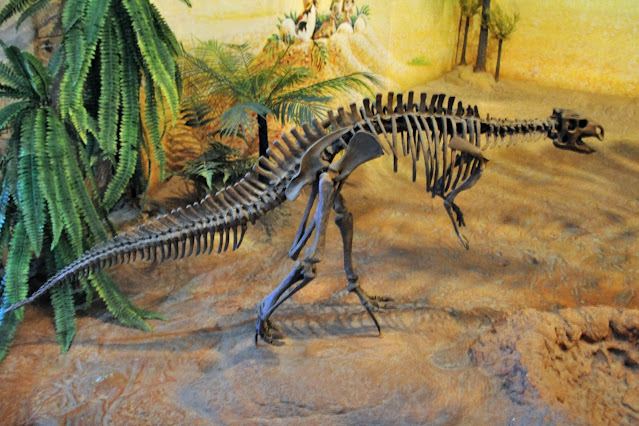
Exhibit at the Sirindhorn Dinosaur Museum.

Exhibit at the Sirindhorn Dinosaur Museum.

Exhibit at the Sirindhorn Dinosaur Museum.

Exhibit at the Sirindhorn Dinosaur Museum.

Exhibit at the Sirindhorn Dinosaur Museum.

Exhibit at the Sirindhorn Dinosaur Museum.

Exhibit at the Sirindhorn Dinosaur Museum.

In the middle of the Sirindhorn Dinosaur Museum, several dinosaur skeletons are displayed.

In the middle of the Sirindhorn Dinosaur Museum, several dinosaur skeletons are displayed.

In the middle of the Sirindhorn Dinosaur Museum, several dinosaur skeletons are displayed.

In the middle of the Sirindhorn Dinosaur Museum, several dinosaur skeletons are displayed.

In the middle of the Sirindhorn Dinosaur Museum, several dinosaur skeletons are displayed.

In the middle of the Sirindhorn Dinosaur Museum, several dinosaur skeletons are displayed.

Dinosaur skulls are housed in the center of the Sirindhorn Dinosaur Museum.

Dinosaur skulls are housed in the center of the Sirindhorn Dinosaur Museum.

Dinosaur skulls are housed in the center of the Sirindhorn Dinosaur Museum.

Exhibit at the Sirindhorn Dinosaur Museum.

Exhibit at the Sirindhorn Dinosaur Museum.

Exhibit at the Sirindhorn Dinosaur Museum.

Early human evolution. The last zone contains skulls of various hominins, from 4 million years old to Homo erectus ("Javanese") of Sangiran in Java, Neanderthals (Homo neanderthalensis) and finally modern Cro-Magnon (Homo sapiens) from Germany.

Early human skulls exhibit at the Sirindhorn Dinosaur Museum.

Early human skulls exhibit at the Sirindhorn Dinosaur Museum.

Homo erectus is an extinct species of hominid that lived throughout most of the Pleistocene geological epoch. Its earliest fossil evidence dates to 1.9 million years ago and the most recent to 70,000 years ago.

Neanderthals were a species of human in the genus Homo which became extinct around 40,000 ago.
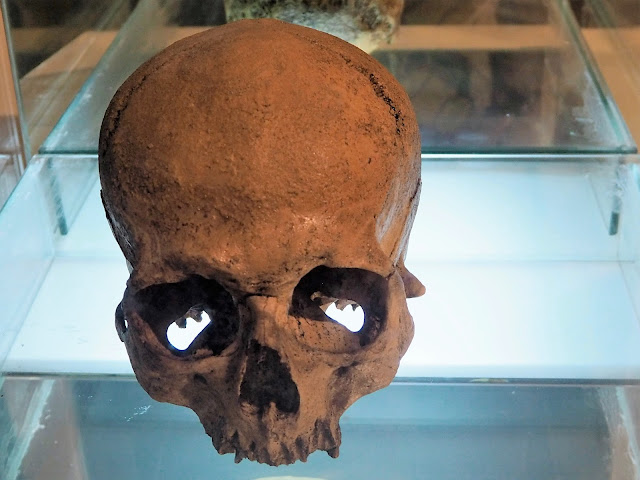
Homo sapiens is the binomial nomenclature for the only extant human species. Homo is the human genus, which also includes Neanderthals and many other extinct species of hominid; H. sapiens is the only surviving species of the genus Homo.

Australopithecus afarensis skeleton "Lucy".

Australopithecus afarensis skeleton "Lucy".

Kalasin City Shrine.

Phraya Chaisunthon Monument (Chao Somphamit). This monument is in front of the Kalasin post office in the city. The life-sized monument is made from bronze in a standing position with the right hand holding a teapot, and left hand holding a magic sword. The people of Kalasin donated the money to build this monument so to express their gratitude to the founder of the city. Phraya Chai Sunthon or Thao Somphamit evacuated people from the left bank of the Mekong River to settle along the Pao River over 200 years ago.

Wat Klang is a third-class royal temple in Kalasin. Within the temple’s compound, there is an Ubosot (chapel), which was once an extension from the old building.

Wat Klang is a third-class royal temple in Kalasin.

Kalasin Wat Klang ubosot is decorated with Chofa (gable finials) and Baraka (crocketts).

Wat Klang is a third-class royal temple in Kalasin.

Wat Klang is a third-class royal temple in Kalasin.

Kalasin Wat Klang wooden doors are ornately carved to depict the story of the Lord Buddha and the Buddhist theme is continued on at the windows. There are stucco door statues – “guardians” - in the front and at the rear.

Wat Klang is a third-class royal temple in Kalasin.

Wat Klang is a third-class royal temple in Kalasin.

Wat Klang is a third-class royal temple in Kalasin.

Kalasin Wat Klang pavilion or Sala near the Ubosot is a beautiful, black Buddha image made from bronze with a lap 20 inches wide.

Wat Tai Pho Kham in Kalasin.

Wat Tai Pho Kham in Kalasin.
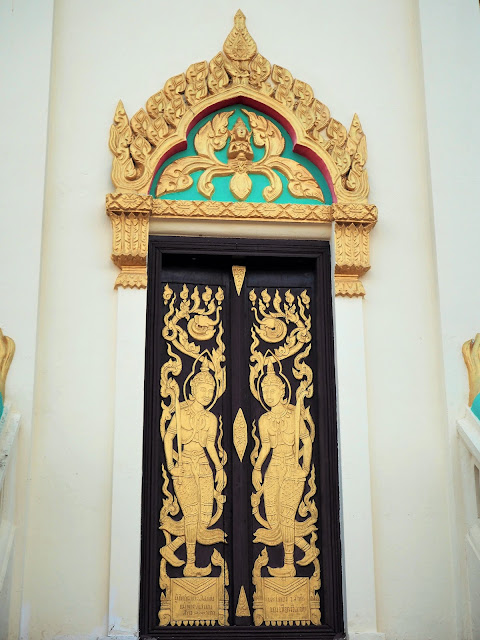
Wat Tai Pho Kham in Kalasin.

Wat Tai Pho Kham in Kalasin.

Wat Tai Pho Kham in Kalasin.
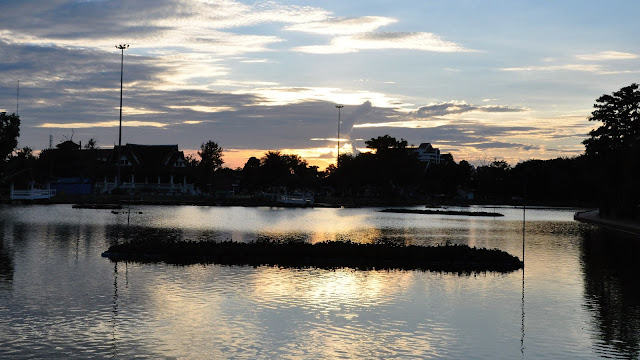
Beautiful sunset at the Kud Nam Kin Lake, Kalasin.

Beautiful sunset at the Kud Nam Kin Lake, Kalasin.

Our dinner at a shop beside AP Garden hotel in Kalasin - nice fried rice and tomyum.

Our dinner at a shop beside AP Garden hotel in Kalasin - Tom-yum Thai soup cooked with shrimps.
| Day 4 | Cost Item in Thai Baht | Bus/car | Food | Hotel | Fee | Total | per pax |
| 19.11.2015 | Breakfast | 300 | 300 | 75 | |||
| Kalasin | Song taew to bus terminal | 36 | 36 | 9 | |||
| AP Garden | Bus to Kalasin | 232 | 232 | 58 | |||
| Song taew to hotel | 80 | 80 | 20 | ||||
| Hotel AP Garden - 2 rooms | 800 | 800 | 200 | ||||
| Van to Dino Museum | 200 | 200 | 50 | ||||
| Lunch | 115 | 115 | 29 | ||||
| Entrance to Dino Museum | 200 | 200 | 50 | ||||
| Van back to Kalasin | 200 | 200 | 50 | ||||
| Dinner | 300 | 300 | 75 |
North-Eastern Thailand and Laos - Introduction
Day 01 (16.11.15) AirAsia AK 856 KUL. 12.45pm to Chiang Mai, (1738km)
Day 02 (17 Nov) Chiang Mai to Loei to Phu Kradueng to Khon Kaen (691km)
Day 03 (18 Nov) Khon Kaen City walk around
Day 04 (19 Nov) Khon Kaen City to Kalasin (80km)
Day 05 (20 Nov) Kalasin to Sakon Nakhon (129km)
Day 06 (21 Nov) Sakon Nakhon to Nakhon Phanom (92km)
Day 07 (22 Nov) Nakhon Phanom - day trip to Thakhek, Laos (62km)
Day 08 (23 Nov) Nakhon Phanom to Mukdahan (125km)
Day 09 (24 Nov) Mukdahan - trip to Phu Pha Thoet National Park (108km)
Day 10 (25 Nov) Mukdahan to Ubon Ratchathani by bus (194km)
Day 11 (26 Nov) Ubon Ratchathani to Pakse to Si Phan Don, Laos (291km)
Day 12 (27 Nov) Si Phan Don - a long walk to Somphamit Waterfall
Day 13 (28 Nov) Si Phan Don to Ubon Ratchathani by bus (291km)
Day 14 (29 Nov) Ubon Ratchathani to Si Sa Ket by van (67km)
Day 15 (30 Nov) Si Sa Ket to Buri Ram by train (148km)
Day 16 (01 Dec) Buri Ram - day visit to 3 places (219km)
Day 17 (02 Dec) Buri Ram to Nakhon Ratchasima by train (129km)
Day 18 (03 Dec) Nakhon Ratchasima - day trip to Phimai (120km)
Day 19 (04 Dec) Nakhon Ratchasima to Bangkok by train (264km)
Day 20 (05 Dec) Bangkok - Chao Phraya River boat ride to Khaosan Road
Day 21 (06 Dec) Bangkok - rest day and dinner at Royal Bangkok Sports Club
Day 22 (07 Dec) Bangkok to Prachuap Khiri Khan by train (320km)
Day 23 (08 Dec) Prachuap Khiri Khan
Day 24 (09 Dec) Prachuap Khiri Khan to Hatyai by night train (660km)
Day 25 (10 Dec) Hatyai to Butterworth by train and to KL by bus (555km)
L-R: Chan Meng Fye, Chew Leng Soon and Ching Neng Bin on the road in Thailand.
///



